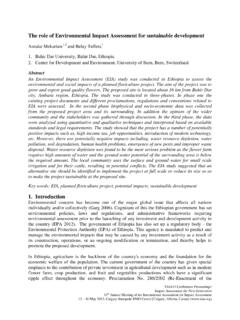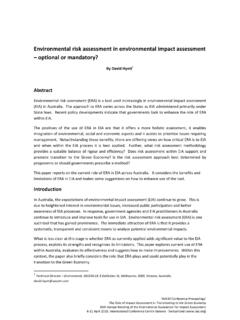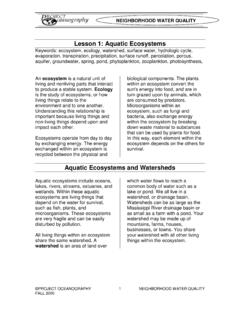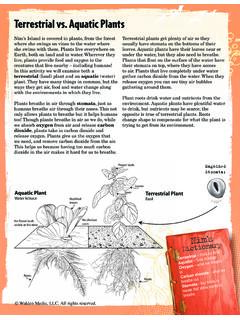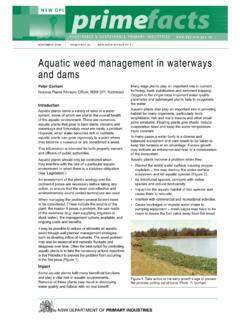Transcription of HEAVY METAL IMPACT ON AQUATIC LIFE AND HUMAN …
1 IAIA17 Conference Proceedings | IA s Contribution in Addressing Climate Change 37th Annual Conference of the International Association for IMPACT Assessment 4 - 7 April 2017 | Le Centre Sheraton | Montr al | Canada | HEAVY METAL IMPACT ON AQUATIC LIFE AND HUMAN HEALTH AN OVER VIEW Dr. Alkesh I. Shah Associate Professor & Head, Zoology Department, B. P. Baria Science Institute, Navsari 396445, Gujarat, India. E mail: Mobile no: +91 9825456680 ABSTRACT: In the industrialization era, pollution has deteriorated the quality and diversity of AQUATIC life.
2 Industries discharge their waste containing HEAVY metals into the water bodies. These HEAVY metals accumulate in different organs of the fish, causing mortality. This effect first appears in blood and affects the fish by alteration of blood components making the fish weak, anemic and vulnerable to diseases. HEAVY metals pollution is thus targeting the major protein source in the form of fish. The exposures to HEAVY metals cause increase or decrease in hematological indices, with decline in protein and glycogen reserves.
3 Therefore the IMPACT of HEAVY metals was carried out on the fish Labeo rohita. HEAVY metals affect the reticulo endothelial system and haematopoisis, changing osmotic resistance of erythrocytes. The red and white blood cells at different stages of the pathological process are subjected to quantitative and qualitative deformation. Key Words: - Labeo rohita, industrialization, AQUATIC life, HEAVY metals, hematology. INTRODUCTION: HEAVY METAL toxicity has proved to be a major threat as several health risks are associated with it.
4 These metals have hardly any biological role to play in the HUMAN body but on the contrary their toxic effect causes malfunctioning of the body system. These elements may sometimes act as pseudo elements of the body, interfering with the metabolic processes that occur in the body. They accumulate in the body resulting into chronic diseases. In order to maintain public health, measures have been taken to control and prevent by treating METAL toxicity occurring at various levels like occupational exposure, accidents and environmental factors.
5 METAL toxicity depends on the absorbed dose, its route as well as duration of exposure. These HEAVY metals bind with protein sites which are not meant for them, by displacing original metals from their natural binding sites causing malfunctioning of cells by their toxicity. Oxidative deterioration of biological macromolecules is primarily due to binding of HEAVY metals to the DNA and nuclear proteins. Industrial waste contain large number of toxicants such as salts of HEAVY metals, acids, organic matter, pesticides and even cyanides which deteriorate the physico-chemical characteristics of water.
6 These pollutants build up in the food chain and are responsible for adverse effects and even death of the organisms in the AQUATIC system. Fish serve as biomarkers of environmental pollution as studies on the overall health are widely carried out in order to evaluate the physiological changes of AQUATIC ecosystems. HEAVY metals are generally referred to as those metals which possess a specific density of above 5 gm/cm3 and adversely affect the environment and living organisms.
7 These metals are quintessential to maintain various biochemical and physiological functions in living organisms in very low concentrations only. These metals prove to be noxious when they exceed certain threshold concentrations. HEAVY metals are significant environmental pollutants and their toxicity is a problem of increasing significance for ecological, evolutionary, nutritional and environmental reasons. The most commonly found HEAVY metals in waste water include copper, nickel, zinc, cobalt and cadmium all of which cause risks for HUMAN health and environment.
8 HEAVY METAL toxicity can lower energy levels and damage the functioning of brain, lungs, kidney, liver and blood composition and other important organs. Long term exposure to high concentrations lead to gradual and progressive physical, muscular and neurological degenerative processes that initiate disease like multiple sclerosis, Parkinson s, Alzheimer s and muscular dystrophy. Repeated long term exposure of some metals and their compounds may cause cancer. Copper: Copper is a trace element which is essential for the function of specific protein enzymes.
9 However, at high concentrations it is toxic to the organisms. The increasing industrial activities and the use of CuSO4 as a fungicide in agricultural practices as well as in the control of algae and pathogens in fish culture ponds have increased the copper concentrations in AQUATIC systems. It is used in combination with lime and water as a protective agent3. Copper sulphate is very toxic to fish. Its toxicity to fish varies with the species and the physical and chemical characteristics of the water9.
10 Nickel: Nickel finds numerous applications in many industries because of its resistance to corrosion, high strength and durability, pleasing appearance, good thermal and electrical conductivity and its ability in forming alloys with other metals. The production of alloys accounts for approximately 75% of total nickel consumption6, 7, 10. The pathogenesis of nickel toxicity is relatively complex because of the large number of chemical and physical forms. Zinc: Zinc, an essential trace METAL becomes toxic when in the nutritional supply it becomes excessive.

